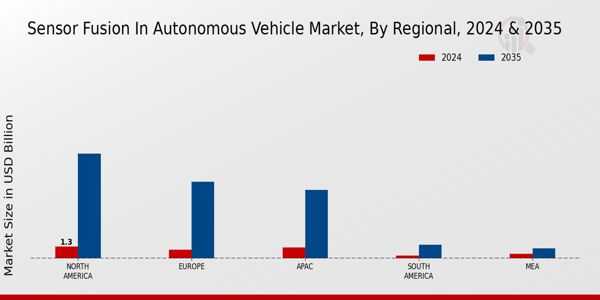Rising Demand for Autonomous Vehicles
The increasing consumer demand for autonomous vehicles is a primary driver in the Sensor Fusion in Autonomous Vehicle Market. As consumers seek enhanced safety, convenience, and efficiency, manufacturers are compelled to integrate advanced sensor technologies. According to recent estimates, the autonomous vehicle market is projected to reach a valuation of over 800 billion by 2030, with sensor fusion playing a critical role in achieving the necessary levels of automation. This demand is further fueled by advancements in artificial intelligence and machine learning, which enhance the capabilities of sensor fusion systems. Consequently, the need for reliable and accurate data processing from multiple sensors is paramount, driving innovation and investment in this sector.
Investment in Research and Development
Investment in research and development (R&D) is a crucial driver for the Sensor Fusion in Autonomous Vehicle Market. As competition intensifies among automotive manufacturers and technology companies, there is a growing emphasis on R&D to enhance sensor fusion capabilities. Companies are allocating substantial resources to develop innovative algorithms and improve data processing techniques, which are essential for effective sensor integration. Reports indicate that R&D spending in the automotive sector is projected to exceed 100 billion annually by 2025, with a significant portion directed towards sensor technologies. This investment not only accelerates the development of advanced sensor fusion systems but also fosters collaboration between automotive and technology firms, further driving market growth.
Collaboration with Technology Providers
Collaboration with technology providers is emerging as a key driver in the Sensor Fusion in Autonomous Vehicle Market. Automotive manufacturers are increasingly partnering with tech companies specializing in sensor technologies, artificial intelligence, and data analytics to enhance their autonomous vehicle offerings. These collaborations enable manufacturers to leverage cutting-edge technologies and expertise, facilitating the development of sophisticated sensor fusion systems. For instance, partnerships with companies focused on machine learning can lead to improved algorithms for data interpretation, enhancing vehicle decision-making capabilities. As the market evolves, such collaborations are likely to become more prevalent, driving innovation and accelerating the deployment of sensor fusion technologies in autonomous vehicles.
Regulatory Support and Safety Standards
Regulatory support and the establishment of safety standards are vital drivers in the Sensor Fusion in Autonomous Vehicle Market. Governments worldwide are increasingly recognizing the potential of autonomous vehicles to improve road safety and reduce traffic congestion. As a result, they are implementing regulations that encourage the development and deployment of sensor fusion technologies. For example, safety standards set by organizations such as the National Highway Traffic Safety Administration (NHTSA) are pushing manufacturers to adopt advanced sensor systems to meet compliance requirements. This regulatory environment not only fosters innovation but also instills consumer confidence in autonomous vehicles. The alignment of regulatory frameworks with technological advancements is expected to accelerate the adoption of sensor fusion solutions in the automotive sector.
Technological Advancements in Sensor Technologies
Technological advancements in sensor technologies are significantly influencing the Sensor Fusion in Autonomous Vehicle Market. Innovations in LiDAR, radar, and camera systems have improved the accuracy and reliability of data collection, which is essential for effective sensor fusion. For instance, the integration of high-resolution cameras with LiDAR systems allows for better environmental perception, which is crucial for autonomous navigation. The market for LiDAR alone is expected to grow at a compound annual growth rate of over 20% in the coming years. These advancements not only enhance the performance of autonomous vehicles but also reduce costs, making sensor fusion technologies more accessible to manufacturers. As a result, the continuous evolution of sensor technologies is likely to propel the growth of the sensor fusion market.

















Leave a Comment